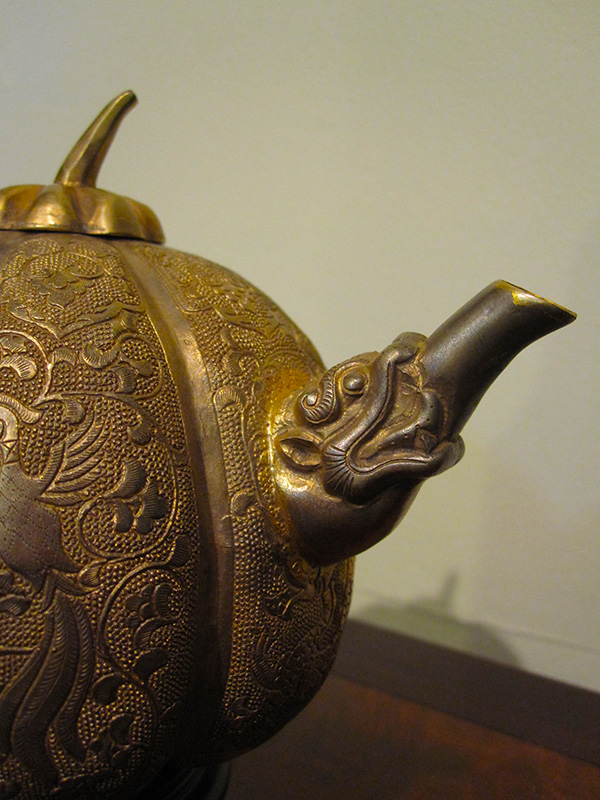This video shows a very elaborate and ceremonial demonstration of a tea gathering by Didi Ryu and two other women, who are not credited by name. I believe that she works for a company called “Golden Damo Puerh Tea,” but I was unable to find any details on the company. The purpose of the demonstration was to prepare and present tea as it would have been done in the late Tang Dynasty, according to the procedures laid out by Lu Yu in the Cha Jing. It appears likely that they also relied on paintings from that time period for some of the stylistic detail.
Disclaimer: since I was unable to understand that narrative or read the text overlays since they were in Mandarin, I only have the information that I was able to glean by observation.
 I can’t vouch for the accuracy of the preparation and ceremony itself, aside from recognizing that they are using accurate tools from that time, but I do believe that they were genuinely attempting to portray historical accuracy. The steps and procedures follow what we know from Lu Yu’s treatise, and the beautiful and elegant presentation is quite interesting to watch. That said, there are a couple of things that disappointed me, all contained within the suspicion that they did not actually prepare any tea in the demonstration.
I can’t vouch for the accuracy of the preparation and ceremony itself, aside from recognizing that they are using accurate tools from that time, but I do believe that they were genuinely attempting to portray historical accuracy. The steps and procedures follow what we know from Lu Yu’s treatise, and the beautiful and elegant presentation is quite interesting to watch. That said, there are a couple of things that disappointed me, all contained within the suspicion that they did not actually prepare any tea in the demonstration.
One indicator is that I don’t think that the brazier they’re using is actually burning. There is no steam, the lackadaisical manner in which the attendant is fanning the fire seems ineffective at best, and when the tea is ready to be served into the cups the woman picks up the bowl of the brazier with her bare hands and transports it to the table. No human I know could pick up a metal bowl that had been directly over a coal fire without getting burned.
Also, although we do not get any detailed views of the tea itself, there is a brief glimpse of a standard contemporary puer cake, and the attendant is shown grinding the tea into a fine powder using a mortar. This powdered tea is then transferred into the bowl of the brazier, with the understanding that it is being boiled. After this process, the finished tea is ladled into cups with a spoon, and held out to the audience, but the tea is not shown, and nobody is shown consuming it.
I would be curious to experience tea prepared in this way, but I would want all of the effort to go into producing a fully authentic experience, ending with an actual taste of the tea.
Note: the accompanying photographs are of a teapot in my collection. I believe that it is brass over a clay teapot body, and is probably gold-plated, although some of the plating has worn off. I was told that it was made during the Tang Dynasty and came from Famen Temple. (I can’t verify the accuracy of this, but it is a fascinating piece of tea ware, and is not a reproduction.) Note the similarity in style and motifs to the tea ware pieces used in the demonstration.



September 6, 2013 at 2:57 pm
There was a Golden Da Mo (Mandarin for Dharma) Pu’er cake around 8 years ago selling for what seemed a shocking amount of money at the time (2 years before the peak of the Pu’er boom.) It was packaged in beautiful hand-made paper and accompanied by mystical verbiage, but to my taste it wasn’t any better than some much cheaper Jingmaishan tea it reminded me of.
November 13, 2013 at 12:11 am
Tang Dynasty culture is related to tea culture a lot. It is interesting to know how people in Tang Dynasty prepare and present tea
December 1, 2013 at 11:19 am
That’s some goofy shit. The foremothers of Mr. Sleeves right there. Do you suppose that show took place at a tea-themed casino?
I have a Golden Damo production I was gifted a couple years ago. Lovely full-sized octagonal paperboard box, but a mini-bing inside. Pretty good for shu, nice mineral flavors. I would scan you the back cover but it’s barely legible to the eye even if you could read Chinese–brown text on slightly darker brown sparkly background. Per Lew, Golden Damo is a line from 今雨轩, a Kunming shop that goes by Teahub in English.
December 13, 2013 at 6:40 am
Do you have the information on the Didi Ryu performing the ceremony?
Best,
January 25, 2014 at 6:28 pm
I doubt the performers would be skilled enough to do the entire ceremony. This is clearly a performance to show the movements but it was not an easy task to keep fire at the right temperature (it was also inside!). I even doubt it was done as ceremoniously as in this performance. It is more like a modern ceremony with an old tea making method.
But I agree, seeing and tasting tang dynasty would be a nice experience. We probably will not like the taste 😉